
🔗 아이템 9. try-finally 대신 try-with-resources를 사용하라
자바 라이브러리에는 close 메서드를 호출해 직접 닫아줘야 하는 자원이 많다.
ex) InputStream, OutputStream, java.sql.Connection
자원 닫기는 클라이언트가 놓치기 쉬워서 예측할 수 없는 성능 문제로 이어지기도 한다.
전통적으로 자원이 제대로 닫힘을 보장하는 수단으로 try-finally가 쓰였다.
💎 try-finally
try-finally - 더 이상 자원을 회수하는 최선의 방책이 아니다!
public static String firstLineOfFile(String path) throw IOException {
BufferedReader br = new BufferedReader(new FileReader(path));
try {
return br.readLine();
} finally {
br.close();
}
}자원이 둘 이상이면 try-finally 방식은 너무 지저분하다!
static void copy(String src, String dst) throws IOException {
InputStream in = new FileInputStream(src);
try {
OutputStream out = new FileOutputStream(dst);
try {
byte[] buf = new byte[BUFFER_SIZE];
int n;
while ((n = in.read(buf)) >= 0)
out.write(buf, 0, n);
} finally {
out.close();
}
} finally {
in.close();
}
}앞의 두 코드 예제에는 결점이 있다.
예외는 try 블록과 finally 블록 모두에서 발생할 수 있다. (자원을 해제하는 close 메서드를 호출할 때)
finally 블록 내에서 다시 try-finally 를 사용하게 되면, 코드는 길어지고 가독성도 떨어진다.
💎 try-with-resources
이 구조를 사용하려면 해당 자원이 AutoCloseable 인터페이스를 구현해야한다.
(AutoCloseable: 단순히 void를 반환하는 close 메서드 하나만 정의한 인터페이스다.)
닫아야 하는 자원을 뜻하는 클래스를 작성한다면 AutoCloseable을 반드시 구현해야 한다.
다음은 try-with-resources를 이용해 위의 두 예제 코드를 재작성한 예다.
try-with-resources - 자원을 회수하는 최선책!
public static String firstLineOfFile(String path) throw IOException {
try (BufferedReader br = new BufferedReader(new FileReader(path))) {
return br.readLine();
} catch (Exception e) {
return defaultVal;
}
}try-with-resources에서도 catch 절을 쓸 수 있다.
복수의 자원을 처리하는 try-with-resources - 짧고 매혹적이다!
static void copy(String src, String dst) throws IOException {
try (InputStream in = new FileInputStream(src);
OutputStream out = new FileOutputStream(dst)) {
byte[] buf = new byte[BUFFER_SIZE];
int n;
while ((n = in.read(buf)) >= 0)
out.write(buf, 0, n);
}
}ex)
public class MyResource implements AutoCloseable {
public void doSomething() throws FirstError {
System.out.println("doing something");
throw new FirstError();
}
@Override
public void close() throws SecondException {
System.out.println("clean my resource");
throw new SecondError();
}
}public class FirstError extends RuntimeException { }
public class SecondError extends RuntimeException { }public class AppRunner {
public static void main(String[] args) {
MyResource myResource = new MyResource();
try {
myResource.doSomething();
} finally {
myResource.close();
}
}
}이렇게 코드를 작성하면, try 블록과 finally 블록에서 모두 예외가 발생할 수 있는데,
두 번째 예외가 첫 번째 예외를 완전히 집어삼켜 버린다.
그러면 스택 추적 내역에 첫 번째 예외에 관한 정보는 남지 않게 되어, 실제 시스템에서의 디버깅을 어렵게 한다.
public class AppRunner {
public static void main(String[] args) {
try (MyResource myResource = new MyResource()){
myResource.doSomething();
}
}
}코드를 이렇게 try-with-resources로 고치면 close를 알아서 호출해주며,
close 호출에서 예외가 발생했을 때, close에서 발생한 예외는 숨겨지고 첫 번째 예외가 기록된다.
이렇게 실전에서는 예외 하나만 보존되고 여러 개의 다른 예외가 숨겨질 수 있다.
이렇게 숨겨진 예외들은 스택 추적 내역에 suppressed 꼬리표를 달고 출력된다.
또한 자바7에서 Throwable에 추가된 getSuppressed 메서드를 쓰면 프로그램 코드에서 가져올 수 있다.
💎 결론
꼭 회수해야 하는 자원을 다룰 때는 try-finally 말고 try-with-resources를 사용하자.
예외는 없다. 코드는 더 짧고 분명해지고, 만들어지는 예외 정보도 훨씬 유용하다.
try-finally로 작성하면 실용적이지 못할 만큼 코드가 지저분해지는 경우라도, try-with-resources로는 정확하고 쉽게 자원을 회수할 수 있다. **
